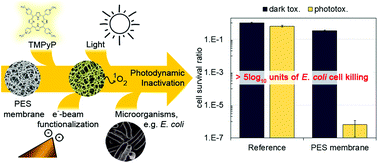当前位置:
X-MOL 学术
›
Photochem. Photobiol. Sci.
›
论文详情
Our official English website, www.x-mol.net, welcomes your
feedback! (Note: you will need to create a separate account there.)
Electron beam functionalized photodynamic polyethersulfone membranes – photophysical characterization and antimicrobial activity
Photochemical & Photobiological Sciences ( IF 2.7 ) Pub Date : 2018-08-22 00:00:00 , DOI: 10.1039/c8pp00254a Alexander Müller 1, 2, 3 , Annegret Preuß 1, 2, 3 , Tobias Bornhütter 1, 2, 3 , Isabell Thomas 3, 4, 5 , Andrea Prager 3, 4, 5 , Agnes Schulze 3, 4, 5 , Beate Röder 1, 2, 3
Photochemical & Photobiological Sciences ( IF 2.7 ) Pub Date : 2018-08-22 00:00:00 , DOI: 10.1039/c8pp00254a Alexander Müller 1, 2, 3 , Annegret Preuß 1, 2, 3 , Tobias Bornhütter 1, 2, 3 , Isabell Thomas 3, 4, 5 , Andrea Prager 3, 4, 5 , Agnes Schulze 3, 4, 5 , Beate Röder 1, 2, 3
Affiliation

|
Polymer membranes are powerful filtration tools in medicine and water treatment. Their efficiency and operational lifetime is limited by biofouling caused by microorganisms. This study describes the development of photodynamical active antimicrobial polymer membranes in a one-pot functionalization step using a well-known photosensitizer (PS). Commercially available polyethersulfone (PES) membranes for microfiltration were doped with the polycationic PS TMPyP using electron beam irradiation. These membranes were characterized in terms of binding stability and quantification of the PS and membrane morphology. Furthermore, the photodynamic ability was verified by time resolved singlet oxygen luminescence scans and successfully tested against the Gram-negative bacterium E. coli under low dose white light illumination resulting in the reduction in cell survival of 6 log10 units. Finally, in preliminarily experiments the photodynamic action against the Gram-positive bacteria M. luteus and the Gram-negative P. fluorescence and the mold C. cladosporioides was demonstrated. These promising results show the high photodynamic potential of electron beam functionalization of PES membranes with TMPyP. It preserves the photodynamic abilities of the immobilized PS resulting in efficient photodynamic inactivation of bacteria and mold on the membrane surface. The uprising worldwide spread of antibiotic resistant bacteria makes the development of new antibacterial strategies an inevitable challenge. The photodynamic inactivation of bacteria and its adaptation for antimicrobial surfaces, e.g. filtration membranes for water treatment, displays many advantages in terms of a wide application range, low mutagenic potential and environmental compatibility.
中文翻译:

电子束功能化的光动力聚醚砜膜–光物理特征和抗菌活性
聚合物膜是药物和水处理中的强大过滤工具。它们的效率和使用寿命受微生物引起的生物污染的限制。这项研究描述了使用众所周知的光敏剂(PS)在一锅功能化步骤中开发光动力活性抗菌聚合物膜的过程。使用电子束辐照,用聚阳离子PS TMPyP掺杂用于微滤的市售聚醚砜(PES)膜。这些膜的特征在于结合稳定性,PS定量和膜形态。此外,通过时间分辨单线态氧发光扫描验证了光动力能力,并成功地针对革兰氏阴性细菌大肠杆菌进行了测试。在低剂量白光照射下,细胞存活率降低了6 log 10个单位。最后,在初步实验中,其对革兰氏阳性细菌黄褐腐杆菌和革兰氏阴性荧光和霉菌C. cladosporioides的光动力作用被证明了。这些有希望的结果表明,用TMPyP对PES膜进行电子束功能化具有很高的光动力潜力。它保留了固定化PS的光动力能力,从而导致细菌和膜表面霉菌的有效光动力灭活。耐药菌在全球范围内的迅速崛起,使得开发新的抗菌策略成为必然的挑战。细菌的光动力失活及其对抗菌表面(例如用于水处理的滤膜)的适应性在广泛的应用范围,低致突变性和环境相容性方面显示出许多优势。
更新日期:2018-08-22
中文翻译:

电子束功能化的光动力聚醚砜膜–光物理特征和抗菌活性
聚合物膜是药物和水处理中的强大过滤工具。它们的效率和使用寿命受微生物引起的生物污染的限制。这项研究描述了使用众所周知的光敏剂(PS)在一锅功能化步骤中开发光动力活性抗菌聚合物膜的过程。使用电子束辐照,用聚阳离子PS TMPyP掺杂用于微滤的市售聚醚砜(PES)膜。这些膜的特征在于结合稳定性,PS定量和膜形态。此外,通过时间分辨单线态氧发光扫描验证了光动力能力,并成功地针对革兰氏阴性细菌大肠杆菌进行了测试。在低剂量白光照射下,细胞存活率降低了6 log 10个单位。最后,在初步实验中,其对革兰氏阳性细菌黄褐腐杆菌和革兰氏阴性荧光和霉菌C. cladosporioides的光动力作用被证明了。这些有希望的结果表明,用TMPyP对PES膜进行电子束功能化具有很高的光动力潜力。它保留了固定化PS的光动力能力,从而导致细菌和膜表面霉菌的有效光动力灭活。耐药菌在全球范围内的迅速崛起,使得开发新的抗菌策略成为必然的挑战。细菌的光动力失活及其对抗菌表面(例如用于水处理的滤膜)的适应性在广泛的应用范围,低致突变性和环境相容性方面显示出许多优势。









































 京公网安备 11010802027423号
京公网安备 11010802027423号